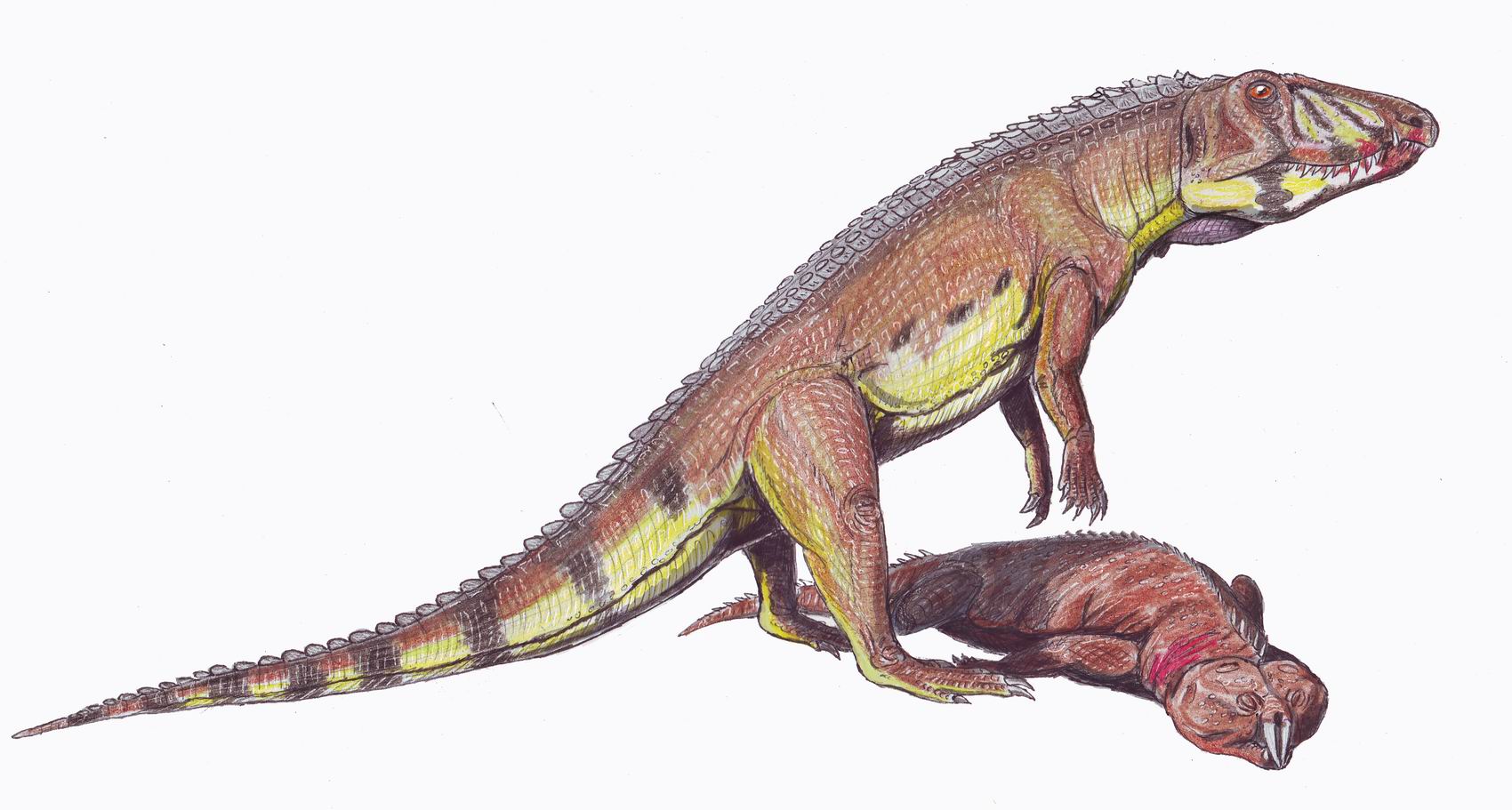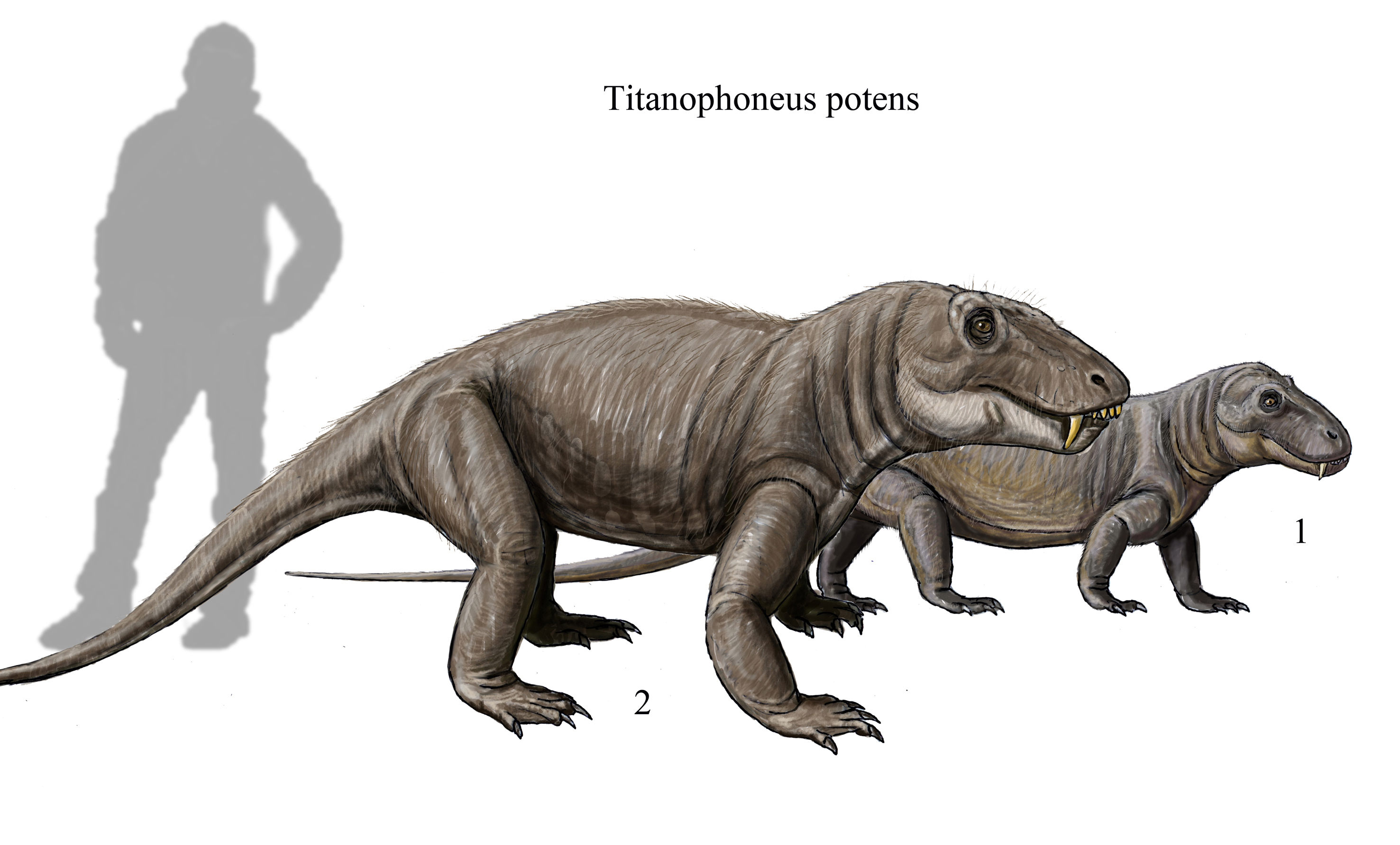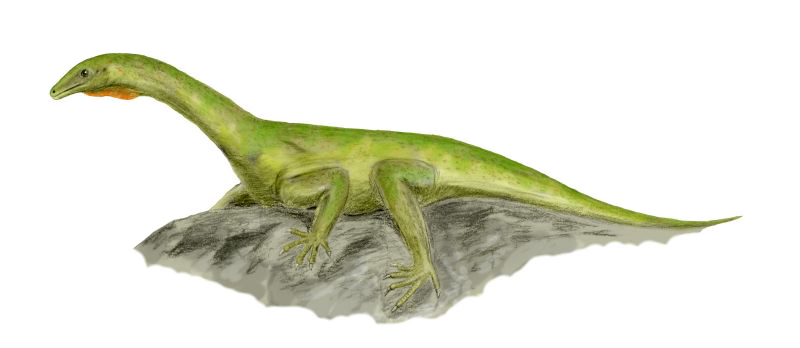|
Archosauromorpha
Archosauromorpha ( Greek for "ruling lizard forms") is a clade of diapsid reptiles containing all reptiles more closely related to archosaurs (such as crocodilians and dinosaurs, including birds) than to lepidosaurs (such as tuataras, lizards, and snakes). Archosauromorphs first appeared during the late Middle Permian or Late Permian, though they became much more common and diverse during the Triassic period. Although Archosauromorpha was first named in 1946, its membership did not become well-established until the 1980s. Currently Archosauromorpha encompasses four main groups of reptiles: the stocky, herbivorous allokotosaurs and rhynchosaurs, the hugely diverse Archosauriformes, and a polyphyletic grouping of various long-necked reptiles including '' Protorosaurus'', tanystropheids, and '' Prolacerta''. Other groups including pantestudines (turtles and their extinct relatives) and the semiaquatic choristoderes have also been placed in Archosauromorpha by some authors ... [...More Info...] [...Related Items...] OR: [Wikipedia] [Google] [Baidu] |
Allokotosauria
Allokotosauria is a clade of early archosauromorph reptiles from the Middle to Late Triassic known from Asia, Africa, North America and Europe. Allokotosauria was first described and named when a new monophyletic grouping of specialized herbivorous archosauromorphs was recovered by Sterling J. Nesbitt, John J. Flynn, Adam C. Pritchard, J. Michael Parrish, Lovasoa Ranivoharimanana and André R. Wyss in 2015. The name Allokotosauria is derived from Greek meaning "strange reptiles" in reference to unexpected grouping of early archosauromorph with a high disparity of features typically associated with herbivory. History Nesbitt ''et al.'' (2015) defined the group as a stem-based taxon containing '' Azendohsaurus madagaskarensis'' and '' Trilophosaurus buettneri'' and all taxa more closely related to them than to ''Tanystropheus longobardicus'', '' Proterosuchus fergusi'', ''Protorosaurus speneri'' or '' Rhynchosaurus articeps''. Therefore, Allokotosauria includes the families Aze ... [...More Info...] [...Related Items...] OR: [Wikipedia] [Google] [Baidu] |
Middle Permian
The Guadalupian is the second and middle series/epoch of the Permian. The Guadalupian was preceded by the Cisuralian and followed by the Lopingian. It is named after the Guadalupe Mountains of New Mexico and Texas, and dates between 272.95 ± 0.5 – 259.1 ± 0.4 Mya. The series saw the rise of the therapsids, a minor extinction event called Olson's Extinction and a significant mass extinction called the end-Capitanian extinction event. The Guadalupian is also known as the Middle Permian. Name and background The Guadalupian is the second and middle series or epoch of the Permian. Previously called Middle Permian, the name of this epoch is part of a revision of Permian stratigraphy for standard global correlation. The name "Guadalupian" was first proposed in the early 1900s, and approved by the International Subcommission on Permian Stratigraphy in 1996. References to the Middle Permian still exist. The Guadalupian was preceded by the Cisuralian and followed by the Lopingian. ... [...More Info...] [...Related Items...] OR: [Wikipedia] [Google] [Baidu] |
Paraphyletic
Paraphyly is a taxonomic term describing a grouping that consists of the grouping's last common ancestor and some but not all of its descendant lineages. The grouping is said to be paraphyletic ''with respect to'' the excluded subgroups. In contrast, a monophyletic grouping (a clade) includes a common ancestor and ''all'' of its descendants. The terms are commonly used in phylogenetics (a subfield of biology) and in the tree model of historical linguistics. Paraphyletic groups are identified by a combination of synapomorphies and symplesiomorphies. If many subgroups are missing from the named group, it is said to be polyparaphyletic. The term received currency during the debates of the 1960s and 1970s accompanying the rise of cladistics, having been coined by zoologist Willi Hennig to apply to well-known taxa like Reptilia (reptiles), which is paraphyletic with respect to birds. Reptilia contains the last common ancestor of reptiles and all descendants of that ancestor exc ... [...More Info...] [...Related Items...] OR: [Wikipedia] [Google] [Baidu] |
Clade
In biology, a clade (), also known as a Monophyly, monophyletic group or natural group, is a group of organisms that is composed of a common ancestor and all of its descendants. Clades are the fundamental unit of cladistics, a modern approach to taxonomy adopted by most biological fields. The common ancestor may be an individual, a population, or a species (extinct or Extant taxon, extant). Clades are nested, one in another, as each branch in turn splits into smaller branches. These splits reflect evolutionary history as populations diverged and evolved independently. Clades are termed ''monophyletic'' (Greek: "one clan") groups. Over the last few decades, the cladistic approach has revolutionized biological classification and revealed surprising evolutionary relationships among organisms. Increasingly, taxonomists try to avoid naming Taxon, taxa that are not clades; that is, taxa that are not Monophyly, monophyletic. Some of the relationships between organisms that the molecul ... [...More Info...] [...Related Items...] OR: [Wikipedia] [Google] [Baidu] |
Greek Language
Greek (, ; , ) is an Indo-European languages, Indo-European language, constituting an independent Hellenic languages, Hellenic branch within the Indo-European language family. It is native to Greece, Cyprus, Italy (in Calabria and Salento), southern Albania, and other regions of the Balkans, Caucasus, the Black Sea coast, Asia Minor, and the Eastern Mediterranean. It has the list of languages by first written accounts, longest documented history of any Indo-European language, spanning at least 3,400 years of written records. Its writing system is the Greek alphabet, which has been used for approximately 2,800 years; previously, Greek was recorded in writing systems such as Linear B and the Cypriot syllabary. The Greek language holds a very important place in the history of the Western world. Beginning with the epics of Homer, ancient Greek literature includes many works of lasting importance in the European canon. Greek is also the language in which many of the foundational texts ... [...More Info...] [...Related Items...] OR: [Wikipedia] [Google] [Baidu] |
Archosauriformes
Archosauriformes (Ancient Greek, Greek for 'ruling lizards', and Latin for 'form') is a clade of diapsid reptiles encompassing Archosaur, archosaurs and some of their close relatives. It was defined by Jacques Gauthier (1994) as the clade stemming from the Most recent common ancestor, last common ancestor of Proterosuchidae and Archosauria. Phil Senter (2005) defined it as the most exclusive clade containing ''Proterosuchus'' and Archosauria. Gauthier as part of the ''Phylonyms'' (2020) defined the clade as the last common ancestor of ''Chicken, Gallus'', ''Alligator'', and ''Proterosuchus'', and all its descendants. Archosauriforms are a branch of Archosauromorpha, archosauromorphs which originated in the Late Permian (roughly 252 million years ago) and persist to the present day as the two surviving archosaur groups: Crocodilia, crocodilians and Bird, birds. Archosauriforms present several traits historically ascribed to the group Archosauria. These include serrated teeth set in ... [...More Info...] [...Related Items...] OR: [Wikipedia] [Google] [Baidu] |
Tasmaniosaurus
''Tasmaniosaurus'' ('lizard from Tasmania', although this genus is not a true lizard) is an Extinction, extinct genus of Archosauromorpha, archosauromorph reptile known from the Knocklofty Formation (Early Triassic) of West Hobart, Tasmania, Australia. The type species is ''T. triassicus''. This genus is notable not only due to being one of the most complete Australian Triassic reptiles known, but also due to being a very close relative of Archosauriformes. Once believed to be a Proterosuchidae, proterosuchid, this taxon is now believed to have been intermediate between advanced non-archosauriform archosauromorphs such as ''Prolacerta'', and basal archosauriforms such as ''Proterosuchus''. Features traditionally used to define Archosauria and later Archosauriformes, such as the presence of an antorbital fenestra and serrated teeth, are now known to have evolved prior to those groups due to their presence in ''Tasmaniosaurus''. History and Classification First named as a ''nomen ... [...More Info...] [...Related Items...] OR: [Wikipedia] [Google] [Baidu] |
Teyujagua
''Teyujagua'' (named for Teyú Yaguá, a legendary beast from local Guaraní mythology) is an extinct genus of small, probably semi-aquatic archosauromorph reptile that lived in Brazil during the Early Triassic period. The genus contains the type and only known species, ''T. paradoxa''. It is known from a well-preserved skull, and probably resembled a crocodile in appearance. It was an intermediary between the primitive archosauromorphs and the more advanced Archosauriformes, revealing the mosaic evolution of how the key features of the archosauriform skull were acquired. ''Teyujagua'' also provides additional support for a two-phase model of archosauriform radiation, with an initial diversification in the Permian followed by a second adaptive radiation in the Early Triassic. Description ''Teyujagua'' is known only from a well preserved skull with four associated cervical vertebrae, the only known postcranial material, but it is inferred to have been a small, carnivorous quadr ... [...More Info...] [...Related Items...] OR: [Wikipedia] [Google] [Baidu] |
Prolacertidae
Prolacertidae is an extinct family of archosauromorph reptiles that lived during the Early Triassic epoch. It was named in 1935 by the British palaeontologist Francis Rex Parrington to include the species '' Prolacerta broomi'' of South Africa and Antarctica. In 1979 a second species, '' Kadimakara australiensis'', was described from Australia. Several other genera, such as '' Macrocnemus'', '' Pamelaria'' and '' Prolacertoides'', have also been assigned to this family in the past, but these have been placed elsewhere by later studies, leaving ''Prolacerta'' and ''Kadimakara'' as the only well-supported members. The prolacertids were historically placed within the paraphyletic group Prolacertiformes along with other basal, long-necked archosauriforms like ''Protorosaurus'' and the tanystropheids. However, more recent research has shown that the prolacertids were only distantly related to other "prolacertiforms", and were instead among the closest relatives of Archosauriformes. ... [...More Info...] [...Related Items...] OR: [Wikipedia] [Google] [Baidu] |
Boreopricea
''Boreopricea'' is an extinct genus of archosauromorph reptile from the Early Triassic of arctic Russia. It is known from a fairly complete skeleton discovered in a borehole on Kolguyev Island, though damage to the specimen and loss of certain bones has complicated study of the genus. ''Boreopricea'' shared many similarities with various other archosauromorphs, making its classification controversial. Various studies have considered it a close relative of '' Prolacerta'', tanystropheids, both, or neither. ''Boreopricea'' is unique among early archosauromorphs due to possessing contact between the jugal and squamosal bones at the rear half of the skull. History ''Boreopricea funerea'' was named and described by Soviet paleontologist L. P. Tatarinov in 1978. It was primarily based on a fairly complete skull and skeleton collected in 1972 from a borehole at Kolguyev Island in the Arctic Ocean. This holotype specimen, PIN 3708/1, included bones from most of the body, apart fro ... [...More Info...] [...Related Items...] OR: [Wikipedia] [Google] [Baidu] |
Rhynchosauria
Rhynchosaurs are a group of extinct herbivorous Triassic archosauromorph reptiles, belonging to the order Rhynchosauria. Members of the group are distinguished by their triangular skulls and elongated, beak like premaxillary bones. Rhynchosaurs first appeared in the Early Triassic, reaching their broadest abundance and a global distribution during the Carnian stage of the Late Triassic. Description Rhynchosaurs were herbivores, and at times abundant (in some fossil localities accounting for 40 to 60% of specimens found), with stocky bodies and a powerful beak. Early primitive forms, like '' Mesosuchus'' and '' Howesia'', were generally small, typically lizard-like in build, and had skulls rather similar to the early diapsid ''Youngina'', except for the beak and a few other features. Later and more advanced genera grew to up to two meters in length. The skull in these forms were short, broad, and triangular, becoming much wider than long in the most advanced forms like ''Hyper ... [...More Info...] [...Related Items...] OR: [Wikipedia] [Google] [Baidu] |
Elessaurus
''Elessaurus'' is an extinct genus of archosauromorph from the Early Triassic of Brazil. It contains a single species, ''Elessaurus gondwanoccidens''. It possessed a variety of features common to basal archosauromorphs, particularly basal tanystropheids such as '' Macrocnemus''. However, it is uncertain whether ''Elessaurus'' was a particularly close relative of tanystropheids, and it might instead be closer to other major archosauromorph clades. The genus name refers to "Elessar", an alternate name of the character Aragorn from J.R.R. Tolkien's Lord of the Rings trilogy. Discovery ''Elessaurus'' is known from a single holotype specimen, UFSM 11471, which consists of most of a leg connected to parts of the hip and the base of the tail. Despite being fairly complete by the standards of its locale, many of the specimen's bones are flattened or fragmentary. UFSM 11471 was collected from the Bica São Tomé site, an outcrop of the Sanga do Cabral Formation in Rio Grande do Sul ... [...More Info...] [...Related Items...] OR: [Wikipedia] [Google] [Baidu] |










